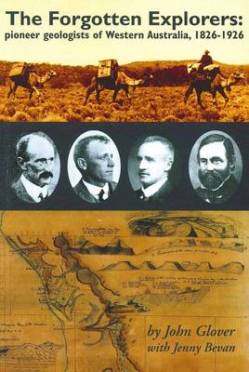The Forgotten Explorers: pioneer geologists of Western Australia,1826-1926

This unusual book will appeal especially to members of the History of Geology Group. Western Australia is one third of the size of the USA and covers one third of Australia. In the early days after British settlement the population numbered about 5000!
The first attempts by French explorer Baudin, and afterwards by the early British settlers at King George Sound (now Albany) and Swan River in 1836, were extremely courageous in reporting and sampling geology. This book tells the story of men travelling on foot or by horse and camel, working with meagre equipment and wearing quite unsuitable dress, in temperatures above 100°F and never sure of water supplies. They include Governors, farmers, surveyors, prospectors and men with limited geological training: the establishment of a proper Geological Survey was delayed and intermittent, due to a preference for prospectors, who did great work but were restricted to on-the-surface mineral finds. The Survey was brought together as an efficient organisation by the remarkable Andrew Gibb Maitland, who led it from 1895 to 1926.
This book describes this remarkable cast of characters, many of unusual origins, eccentric and some difficult to get on with, possessed with strong and often incorrect beliefs about the mineral potential of the State. There was great respect for Murchison, who pontificated about Western Australia’s potential for minerals without ever going there! Some prescient opinions were ignored.
My favourite tale is that of Robert Austin’s 1854 expedition to find pastoral country and minerals, in which one man accidentally shot himself dead and 85% of the horses died by eating poisonous vegetation. Water dried up, yet Austin led them back through unbearable heat to the last visited water hole, 40 miles away (finding it almost dry), and then on to lead mines near Northampton. Gibson, who gave his name to the desert, lost his wits and was never seen again. Lasseter was lost, and there were many vain searches for his fabulous gold lode, probably a chimera.
Patrick Brophy’s camel went 600 miles without water. Then there was ‘Major Patrick Pelly’, whose strange bald visage hung on the walls in the staff room at the Geological Department at the University when I worked there. ‘Pelly’ served diligently for years, getting the records straight, but was actually an ex-convict called Pearson, a Queensland bushranger nicknamed ‘Captain Starlight’ who stole another convict’s identity while in prison. He died by drinking cyanide instead of his medicine.
Jenny Bevan has collected an absolute treasure trove of old pictures, diagrams and documents, such that there are 140 illustrations enriching the text. This is a unique, splendid book.
Reviewed by: Joe McCall
THE FORGOTTEN EXPLORERS: PIONEER GEOLOGISTS OF WESTERN AUSTRALIA,1826-1926 JOHN GLOVER WITH JENNY BEVAN. Published by: Hesperian Press* * PO Box 317, Victoria Park 6979 and 65 Oats Street, Carlisle 6101, Western Australia. (Payment by credit +61 8 9361 2333) Publication: 2010 ISBN: 978-0-85905-473-7 List price: A$36.50 231pp.